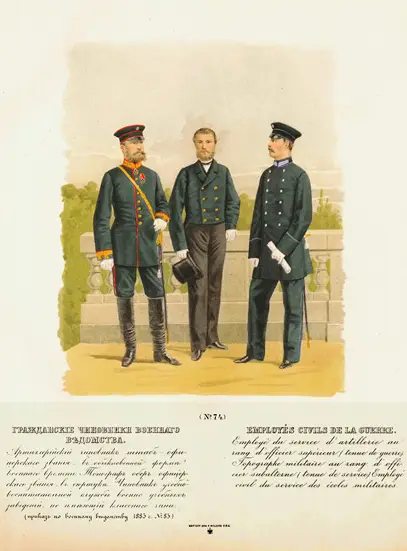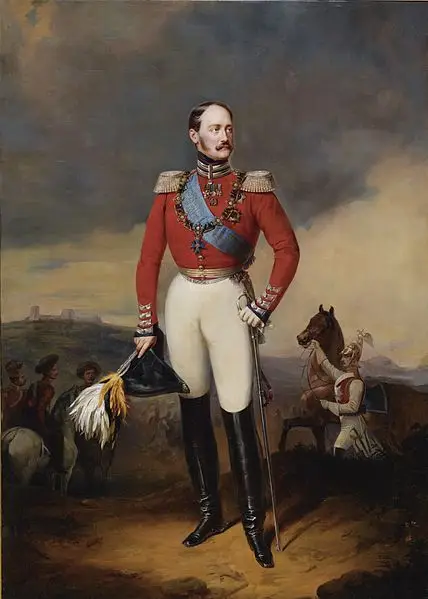How Nicholas I unified the uniform system in Russia

Civilian officials of the War Department
The need for unification
In the first years of the reign of Emperor Nikolai Pavlovich, it became clear that there was no unification in the uniform sewing system in various departments. Also, officials did not always wear the uniforms prescribed for them. In particular, in August 1828, Tsar Nicholas I visited the Senate, where he found many civil servants, mostly in multi-colored uniforms and “striped trousers.”
Nikolai Pavlovich wrote a letter to the Prosecutor General, Prince D.I. Lobanov-Rostovsky on this matter, where he said that he wanted and demanded everywhere due order, plausibility and decency worthy of the Senate. The Emperor ordered officials who were required to wear uniforms to come to the Senate only in them, which was to be monitored by chief prosecutors (L. E. Shepelev. Titles, uniforms, orders in the Russian Empire. M. 1991).
Back in April, 1828, the sovereign ordered to deliver samples of all forms of civilian government (apparently, uniforms were meant) to the First Division of the Imperial Chancellery. The first office of His Own Imperial Majesty's Office was engaged in the preparation of state decrees, orders and rescripts, led the control over their execution, the presentation of reports and petitions to the king.
The practice of wearing uniforms by civil officials and nobles dates back to the 1780s. It was explained not only by the need to outwardly distinguish civil servants, but also by the desire to limit the luxury of the attire of the nobility. After all, rich aristocrats could stand out greatly from ordinary nobles.
At the beginning of the 19th century, with the establishment of ministries in the empire, departmental uniforms also appeared. During this period, they were made according to the French fashion: narrow, single-breasted, with a stand-up collar, with pocket flaps on the hips and a cutout in the front below the waist.

Emperor Nicholas I (1835). Hood. Franz Kruger
Reform
In 1829, E.I.V.’s Own Office received the task of developing a draft “General Regulations on Civil Forms.” The order was completed only by May 1833, which was explained by the workload of the office with the affairs of the completed Russian-Turkish War of 1828-1829. The manager of the Own Office, A. S. Taneyev, explained the reasons and goals of the reform by the need to establish uniformity. It was also said that in "There are no significant differences in the grades of positions, especially the highest ones"and they are almost the same. Therefore, instead of the private and incomplete provisions that previously existed in some departments, one general provision was developed.
On March 11, 1834, Tsar Nicholas I approved the “Regulations on Civil Uniforms” prepared by H.I.V.’s own office. At the same time, the emperor approved the “Description of Ladies' Attire,” which concerned ceremonial events at the Imperial Court. Thus, one of the first official dress codes was approved in Russia, which was mandatory when visiting certain organizations, institutions and events.
The main theses of the new "Regulations" were as follows. The new law covered the officials of state institutions. As a rule, all institutions of each department in the center and in the field received uniform uniforms. The provincial uniforms of civil servants were abolished. The uniform of the French model was retained, but its cut has changed somewhat due to a clearer cutout in the front. In most cases, the previously established colors of uniforms and sewing patterns were preserved. From this point on, uniforms corresponded only to the rank of the position, and not rank. For the majority of departments, the 10-ryazryadnye division of posts was introduced, it corresponded to the same completeness of sewing on the uniform. This gradation was fixed in staff schedules.
The uniforms were dark green or dark blue, and red was reserved for senators. Most departments received dark green uniforms. Employees of the Ministry of Public Education, the Academy of Arts, the Mining Department, the Department of Communications and Public Buildings, and the Department of Spiritual Affairs of Foreign Denominations had dark blue uniforms.
Uniforms of the 1st category could only be worn by the Chairman of the State Council, the Chancellor of Russia and the Chancellor of the Imperial and Tsarist orders. Uniforms of the 1st category corresponded to the largest amount of sewing. Sewing was located on the collar, cuffs and pocket flaps, along the shoulders and back around the collar (this sewing was introduced for the first time), under the flaps (feather), along the sides, floors and tails in three rows (garlands), along the edges of the back slit and above it (cap), and also along the seams of the back and sleeves. On the 2nd category uniforms there was no sewing at the seams and no third garland. Uniforms of the 3rd category were devoid of sewing around the collar and second garland, and the “feather” was of a simplified shape. The Ministry of Foreign Affairs had full and half stitching on the collar and cuffs of their uniforms.
On the uniforms of the 4 discharge, sewing was maintained only on the collar, cuffs and pocket flaps, and 5, only on the collar and cuffs. The uniforms of the 6 category had half-embroidered collar and cuffs. The uniforms of the 7 category received half-sewing on the collar and sewn edging on the cuffs, and the 8-i had the same, but without the edging on the cuffs. Sewn edging on the collar and cuffs had the uniforms of the 9-th category, and 10-th had only a edging on the collar.
Seven forms of clothing were introduced and the occasions when they were to be worn: formal, festive, ordinary, everyday, special, travel and summer. In 1845, the “Schedule of what days to wear in what form” was published. The uniform was usually indicated on agendas where officials were invited to various events and meetings.
Part of the dress uniform was a triangular black hat with small silver tassels at the ends and a buttonhole with a small button. Officials of grades 1-5 had a twisted buttonhole, similar to a general's, while other grades had a smooth braided buttonhole. The buttonhole covered the cockade (it was considered an important element of the uniform, indicating nationality) in the form of a rosette of three circles of moire ribbon in black (in the center), orange and white. Somewhat later, the fabric cockade was replaced with a metal one. At first it was made in the shape of an ellipse and secured to the band in front, then it became round and was moved to the crown.
In addition, an indispensable part of the uniform was a civilian-style sword with a silver lanyard. It must also be said that a civilian uniform was considered incompatible with the presence of a beard and even a mustache. In 1837, an order was issued to all superiors to strictly ensure that their subordinates did not wear beards or mustaches.
A retired government official could have kept his uniform if he served in the department for at least 10 years and his service did not cause any complaints.
The preparation of the drawings was entrusted to Academician I. A. Ivanov, who was known “with its perspective views and landscapes" Ivanov already had experience in such work: in 1815 he completed the album “Image of the changes that followed in the armament and attire of the Russian army from the half of the XNUMXth to the beginning of the XNUMXth century.”
Ivanov’s work was approved, and the artist received a significant reward for those times - 3 thousand rubles. The original drawings were sent to various departments, where they were to be copied, then they were transferred to the Senate for storage. New uniforms had to be made within one year, during which time the old ones were allowed to be worn.
Under Emperor Alexander II, a half-caftan was added to the ceremonial uniform, and white short trousers disappeared. In this form, the civilian uniform existed until the February Revolution of 1917.

Sword of civil officials, model 1855.
Information